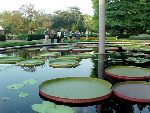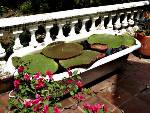|
|
|||
|
|
|||
|
|
|||
|
|
|||
|
|

Final planting is extremely variable. Container size can be from 3 to 200 gallons to a natural bottom pond. We find that we can grow plants with 30-45" pads and numerous blooms through a whole season in 10 gallons of soil, ideal if space is limited. We honestly can't imagine that a 200 gallon pot is necessary for fabulous growth but some use this size. Somewhere in the middle, 20 to 50 gallons will produce superb plants. Lerio pots are available in many sizes but large Rubbermaid containers, concrete mixing tubs and all sorts of other containers work just fine and are probably cheaper.
Soil can be anything from our just-better-than-beach sand
to heavy topsoil with cow manure or clay. Our best recommendation
is to use what is readily available from your yard or garden
center. Victorias are not fussy about soil as adults.
The root ball should be placed in the bottom of the container
with the surrounding soil at the level of the crown so that soil
can be added through the season as the plant grows upward.
We grow most of our adult plants in our version of natural bottom ponds. All are concrete with deeper holes built into some of the bottoms and a layer of sand (8-12") added back. Early in the season we dig these holes out and place the plants in them as deep as possible, adding soil around the crowns when we see new roots (which form at the bases of stems).
Victorias are heavy feeders but it can be easy to overdo it with fertilizer. In sand such as ours, it is very possible to overfeed them to the point of toxicity. The higher the sand component of the soil, the greater the care that must be given to fertilizer quantities. We have excellent results feeding a combination of nutrients weekly based on pad surface area. We give PondTabbs and inject our "cocktail", a combination of Iron Green, fish emulsion and either Roots or Seamate around them. The proportions are approximately the same as in the cocktail we give our babies though much less dilute. See "Weakly Weekly".
In cooler conditions, aphids can be a problem, especially for young plants. Our best suggestion is to wash them off as needed. Larvae of the China Mark moth can also also attack young pads but are rarely much of a problem with adults. Hand picking them off, remembering to check the pad reverses, is usually adequate treatment. Victorias DO NOT LIKE any types of sprays on their pads.
Turtles and ducks are enemies! Crawfish can also damage emerging pads to the point of plant death.
Though we don't start plants in a greenhouse, many do. Excessive heat and/or humidity in the greenhouse can damage leaves, creating light colored patches in the case of high heat, dark patches if the leaves can't dry from humidity, both types of damage with both high heat and humidity. Improving air circulation helps.
When taking plants outside from the greenhouse, care must be taken not to sunburn them. They can be placed where they get only an hour or two of sun initially or protected with some type of screening until they "harden".
Because of their upward growth, Victorias DO NOT LIKE
their new feeder roots above the soil and they DO NOT LIKE the
cavity that forms under the crown as the base of the huge pineapple-like
rhizome rots. In addition to having soil added around the crown,
the plants should be pushed down regularly (with heavy gloves
or wader-clad feet!) to keep this cavity at a minimum. For those
with short growing seasons, this may not be an issue but it definitely
lengthens the life of the plants for those with longer seasons.
More Detailed "Lengthening The Life Of Victoria"
And "Step By Step Repotting Adult Victorias"
Victorias also DO NOT LIKE any foreign objects on their pads!
Even a tiny leaf left on the surface will create a blemish. Many
foreign bodies will result in premature deterioration of the
pad. Where waterlilies are perfectly happy overlapping pads and
competing for space, this is not so with Victoria. Premature
deterioration will result where they overlap.
Victorias can be reluctant to bloom if their pads are damaged or removed prematurely. The second is especially true with plants in small spaces or small containers.
|
|
|||
|
|
|||
|
|
|||
|
|
|||
|
|
|
|
||
|
|
|
Articles |
|
|
|
|
|
|
|
|


